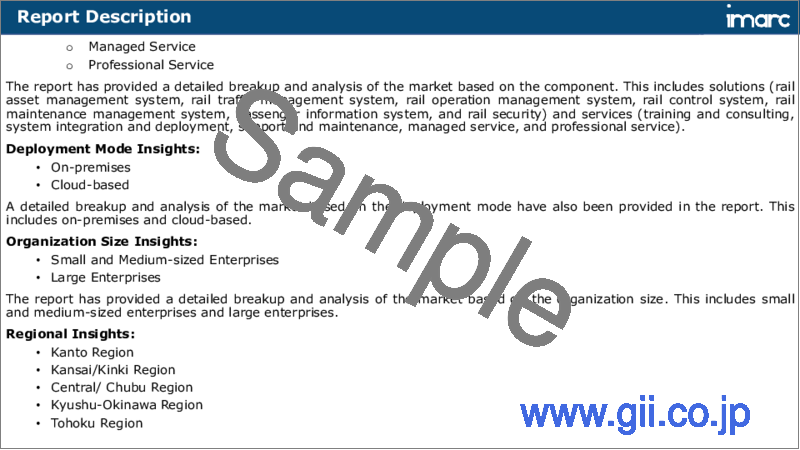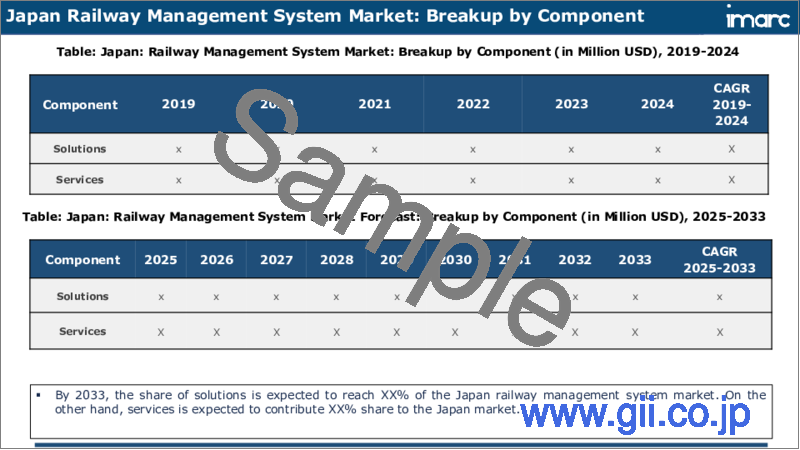|
|
市場調査レポート
商品コード
1609878
日本の鉄道管理システム市場レポート:コンポーネント、展開モード、組織規模、地域別、2025年~2033年Japan Railway Management System Market Report by Component (Solutions, Services), Deployment Mode (On-premises, Cloud-based), Organization Size (Small and Medium-sized Enterprises, Large Enterprises), and Region 2025-2033 |
||||||
カスタマイズ可能
|
|||||||
| 日本の鉄道管理システム市場レポート:コンポーネント、展開モード、組織規模、地域別、2025年~2033年 |
|
出版日: 2024年12月05日
発行: IMARC
ページ情報: 英文 115 Pages
納期: 5~7営業日
|
全表示
- 概要
- 目次
日本の鉄道管理システム市場の市場規模は2024年に37億米ドルに達しました。IMARC Groupは、2025年から2033年にかけての成長率(CAGR)は10.5%で、2033年には90億米ドルに達すると予測しています。人口密集地の存在、スマートシティへの注目の高まり、日本の持続可能性への継続的な取り組み、人工知能(AI)と機械学習(ML)の最近の進歩、観光産業の台頭などが市場を牽引する主な要因のいくつかです。
本レポートで扱う主な質問
- 日本の鉄道管理システム市場はこれまでどのように推移し、今後どのように推移するのか?
- 日本の鉄道管理システム市場にCOVID-19が与えた影響は?
- 日本の鉄道管理システム市場のコンポーネント別の内訳は?
- 日本の鉄道管理システム市場の展開モード別の内訳は?
- 日本の鉄道管理システム市場の組織規模別の内訳は?
- 日本の鉄道管理システム市場のバリューチェーンにはどのような段階がありますか?
- 日本の鉄道管理システムにおける主な促進要因と課題は何か?
- 日本の鉄道管理システム市場の構造と主要プレーヤーは?
- 日本の鉄道管理システム市場における競合の程度は?
目次
第1章 序文
第2章 調査範囲と調査手法
- 調査の目的
- ステークホルダー
- データソース
- 市場推定
- 調査手法
第3章 エグゼクティブサマリー
第4章 日本の鉄道管理システム市場:イントロダクション
- 概要
- 市場力学
- 業界動向
- 競合情報
第5章 日本の鉄道管理システム市場情勢
- 過去および現在の市場動向(2019年~2024年)
- 市場予測(2025-2033)
第6章 日本の鉄道管理システム市場:コンポーネント別の内訳
- ソリューション
- サービス
第7章 日本の鉄道管理システム市場:展開モード別の内訳
- オンプレミス
- クラウドベース
第8章 日本の鉄道管理システム市場:組織規模別の内訳
- 中小企業
- 大企業
第9章 日本の鉄道管理システム市場:競合情勢
- 概要
- 市場構造
- 市場プレーヤーのポジショニング
- 主要成功戦略
- 競合ダッシュボード
- 企業評価象限
第10章 主要企業のプロファイル
第11章 日本の鉄道管理システム市場:業界分析
- 促進要因・抑制要因・機会
- ポーターのファイブフォース分析
- バリューチェーン分析
第12章 付録
Japan railway management system market size reached USD 3.7 Billion in 2024. Looking forward, IMARC Group expects the market to reach USD 9.0 Billion by 2033, exhibiting a growth rate (CAGR) of 10.5% during 2025-2033. The presence of a dense population, escalating focus on smart cities, Japan's ongoing commitment to sustainability, recent advancements in artificial intelligence (AI) and machine learning (ML), and the rising tourism industry some of the key factors driving the market.
Railway management systems refer to the suite of solutions and services used for managing and optimizing railway operations. They are available in various types, such as traffic management, asset management, control systems, and information systems. Railway management systems consist of components like sensors, software, services, and devices to facilitate communication and analytics. They offer numerous features, including real-time monitoring, data collection, scheduling, and asset optimization. Railway management systems find applications in train planning, routing, scheduling, tracking, maintenance, ticketing, and security. Additionally, they are used in passenger information systems, asset and workforce management, and emergency response services. Railway management systems aid in increasing operational efficiency, improving safety, reducing cost, and enhancing customer experience. In addition to this, they provide several advantages, such as real-time decision-making, scalability, data-driven insights, reduced carbon footprint, and interoperability between various systems.
Japan Railway Management System Market Trends:
The presence of a dense population, coupled with the increasing urbanization in Japan, which requires an efficient railway system, is propelling the market growth. Additionally, the escalating focus on smart cities, which involves integrating the Internet of Things (IoT) and big data into public transport, such as railways, is contributing to the market growth. Besides this, the government's commitment to sustainability, prompting the development of eco-friendly and efficient rail systems, is catalyzing the market growth. Furthermore, recent advancements in artificial intelligence (AI) and machine learning (ML) that are enhancing predictive maintenance and safety measures are positively influencing the market growth. In addition, the rising tourism industry, necessitating a well-managed, efficient railway system, is driving the market growth. Apart from this, the growing need for real-time monitoring to ensure safety and schedule adherence, boosting the demand for advanced management systems, is supporting the market growth. Moreover, the increasing number of public-private partnerships, which is aiding rapid technology adoption, is further bolstering the market growth. Along with this, the implementation of favorable regulatory support in transportation infrastructure, creating a conducive environment for the market, is acting as another growth-inducing factor. In addition to this, the introduction of high-speed trains like the Shinkansen, which demand sophisticated management systems for seamless operation, is creating a positive outlook for the market growth. Furthermore, the rapid proliferation of mobile ticketing solutions is fueling the market growth. Besides, the widespread integration of renewable energy sources like solar power into railway operations is providing a boost to the market growth. Additionally, the escalating security concerns, necessitating advanced surveillance and monitoring systems, are accelerating the market growth.
Japan Railway Management System Market Segmentation:
Component Insights:
- Solutions
- Rail Asset Management System
- Rail Traffic Management System
- Rail Operation Management System
- Rail Control System
- Rail Maintenance Management System
- Passenger Information System
- Rail Security
- Services
- Training and Consulting
- System Integration and Deployment
- Support and Maintenance
- Managed Service
- Professional Service
Deployment Mode Insights:
- On-premises
- Cloud-based
Organization Size Insights:
- Small and Medium-sized Enterprises
- Large Enterprises
Competitive Landscape:
The market research report has also provided a comprehensive analysis of the competitive landscape. Competitive analysis such as market structure, key player positioning, top winning strategies, competitive dashboard, and company evaluation quadrant has been covered in the report. Also, detailed profiles of all major companies have been provided.
Key Questions Answered in This Report:
- How has the Japan railway management system market performed so far and how will it perform in the coming years?
- What has been the impact of COVID-19 on the Japan railway management system market?
- What is the breakup of the Japan railway management system market on the basis of component?
- What is the breakup of the Japan railway management system market on the basis of deployment mode?
- What is the breakup of the Japan railway management system market on the basis of organization size?
- What are the various stages in the value chain of the Japan railway management system market?
- What are the key driving factors and challenges in the Japan railway management system?
- What is the structure of the Japan railway management system market and who are the key players?
- What is the degree of competition in the Japan railway management system market?
Table of Contents
1 Preface
2 Scope and Methodology
- 2.1 Objectives of the Study
- 2.2 Stakeholders
- 2.3 Data Sources
- 2.3.1 Primary Sources
- 2.3.2 Secondary Sources
- 2.4 Market Estimation
- 2.4.1 Bottom-Up Approach
- 2.4.2 Top-Down Approach
- 2.5 Forecasting Methodology
3 Executive Summary
4 Japan Railway Management System Market - Introduction
- 4.1 Overview
- 4.2 Market Dynamics
- 4.3 Industry Trends
- 4.4 Competitive Intelligence
5 Japan Railway Management System Market Landscape
- 5.1 Historical and Current Market Trends (2019-2024)
- 5.2 Market Forecast (2025-2033)
6 Japan Railway Management System Market - Breakup by Component
- 6.1 Solutions
- 6.1.1 Overview
- 6.1.2 Historical and Current Market Trends (2019-2024)
- 6.1.3 Market Segmentation
- 6.1.3.1 Rail Asset Management System
- 6.1.3.2 Rail Traffic Management System
- 6.1.3.3 Rail Operation Management System
- 6.1.3.4 Rail Control System
- 6.1.3.5 Rail Maintenance Management System
- 6.1.3.6 Passenger Information System
- 6.1.3.7 Rail Security
- 6.1.4 Market Forecast (2025-2033)
- 6.2 Services
- 6.2.1 Overview
- 6.2.2 Historical and Current Market Trends (2019-2024)
- 6.2.3 Market Segmentation
- 6.2.3.1 Training and Consulting
- 6.2.3.2 System Integration and Deployment
- 6.2.3.3 Support and Maintenance
- 6.2.3.4 Managed Service
- 6.2.3.5 Professional Service
- 6.2.4 Market Forecast (2025-2033)
7 Japan Railway Management System Market - Breakup by Deployment Mode
- 7.1 On-premises
- 7.1.1 Overview
- 7.1.2 Historical and Current Market Trends (2019-2024)
- 7.1.3 Market Forecast (2025-2033)
- 7.2 Cloud-based
- 7.2.1 Overview
- 7.2.2 Historical and Current Market Trends (2019-2024)
- 7.2.3 Market Forecast (2025-2033)
8 Japan Railway Management System Market - Breakup by Organization Size
- 8.1 Small and Medium-sized Enterprises
- 8.1.1 Overview
- 8.1.2 Historical and Current Market Trends (2019-2024)
- 8.1.3 Market Forecast (2025-2033)
- 8.2 Large Enterprises
- 8.2.1 Overview
- 8.2.2 Historical and Current Market Trends (2019-2024)
- 8.2.3 Market Forecast (2025-2033)
9 Japan Railway Management System Market - Competitive Landscape
- 9.1 Overview
- 9.2 Market Structure
- 9.3 Market Player Positioning
- 9.4 Top Winning Strategies
- 9.5 Competitive Dashboard
- 9.6 Company Evaluation Quadrant
10 Profiles of Key Players
- 10.1 Company A
- 10.1.1 Business Overview
- 10.1.2 Product Portfolio
- 10.1.3 Business Strategies
- 10.1.4 SWOT Analysis
- 10.1.5 Major News and Events
- 10.2 Company B
- 10.2.1 Business Overview
- 10.2.2 Product Portfolio
- 10.2.3 Business Strategies
- 10.2.4 SWOT Analysis
- 10.2.5 Major News and Events
- 10.3 Company C
- 10.3.1 Business Overview
- 10.3.2 Product Portfolio
- 10.3.3 Business Strategies
- 10.3.4 SWOT Analysis
- 10.3.5 Major News and Events
- 10.4 Company D
- 10.4.1 Business Overview
- 10.4.2 Product Portfolio
- 10.4.3 Business Strategies
- 10.4.4 SWOT Analysis
- 10.4.5 Major News and Events
- 10.5 Company E
- 10.5.1 Business Overview
- 10.5.2 Product Portfolio
- 10.5.3 Business Strategies
- 10.5.4 SWOT Analysis
- 10.5.5 Major News and Events
11 Japan Railway Management System Market - Industry Analysis
- 11.1 Drivers, Restraints, and Opportunities
- 11.1.1 Overview
- 11.1.2 Drivers
- 11.1.3 Restraints
- 11.1.4 Opportunities
- 11.2 Porters Five Forces Analysis
- 11.2.1 Overview
- 11.2.2 Bargaining Power of Buyers
- 11.2.3 Bargaining Power of Suppliers
- 11.2.4 Degree of Competition
- 11.2.5 Threat of New Entrants
- 11.2.6 Threat of Substitutes
- 11.3 Value Chain Analysis






